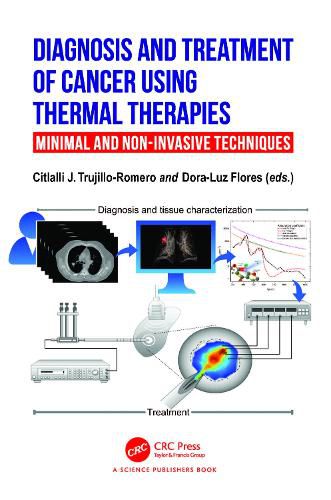Readings Newsletter
Become a Readings Member to make your shopping experience even easier.
Sign in or sign up for free!
You’re not far away from qualifying for FREE standard shipping within Australia
You’ve qualified for FREE standard shipping within Australia
The cart is loading…






New research is being conducted in the diagnosis and new treatments of cancer that has high efficacy and are minimally invasiveness. Artificial intelligence, bioimpedance, thermal images and nanomaterials have been used to provide early diagnosis. New treatments based on the generation of microwaves, radiofrequency, or ultrasound have been proposed in the last couple of decades. Although thermotherapies have been shown to be efficient, for them to be considered as a primary treatment, they must overcome some hurdles. One of the main challenges is to ensure applicators that point the electromagnetic or the mechanical waves at a tumor, don't affect the surrounding healthy tissues. In some cases, nanoparticles have also been designed to achieve better focus. The design of new applicators can be made by computational models based on methods such as the finite element. However, to efficiently predict the applicator's performance, it is important that dielectric, thermal, and acoustic properties (tissue characterization) are included in the models. Not only healthy tissue, but also tumors must be characterized. Patient specific treatment planning, which consists of a 3D patient model based on medical images, can be developed to implement a safety treatment. Moreover, tissue properties as well as the applicator must be defined. Parameters such as temperature increase, and heat pattern must be evaluated to ensure patient safety and treatment success.
$9.00 standard shipping within Australia
FREE standard shipping within Australia for orders over $100.00
Express & International shipping calculated at checkout
New research is being conducted in the diagnosis and new treatments of cancer that has high efficacy and are minimally invasiveness. Artificial intelligence, bioimpedance, thermal images and nanomaterials have been used to provide early diagnosis. New treatments based on the generation of microwaves, radiofrequency, or ultrasound have been proposed in the last couple of decades. Although thermotherapies have been shown to be efficient, for them to be considered as a primary treatment, they must overcome some hurdles. One of the main challenges is to ensure applicators that point the electromagnetic or the mechanical waves at a tumor, don't affect the surrounding healthy tissues. In some cases, nanoparticles have also been designed to achieve better focus. The design of new applicators can be made by computational models based on methods such as the finite element. However, to efficiently predict the applicator's performance, it is important that dielectric, thermal, and acoustic properties (tissue characterization) are included in the models. Not only healthy tissue, but also tumors must be characterized. Patient specific treatment planning, which consists of a 3D patient model based on medical images, can be developed to implement a safety treatment. Moreover, tissue properties as well as the applicator must be defined. Parameters such as temperature increase, and heat pattern must be evaluated to ensure patient safety and treatment success.